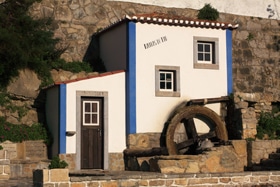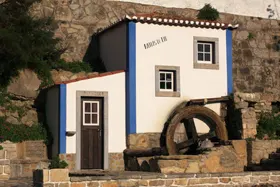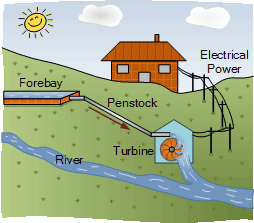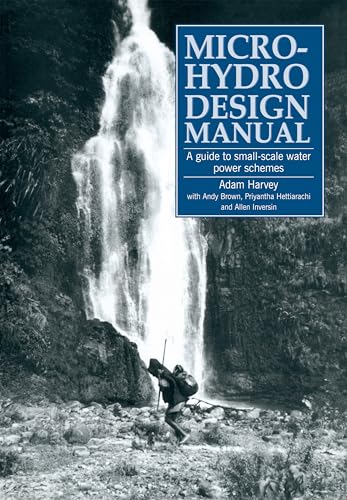
Small Scale Hydro Power
Small Scale Hydro Power for the Home
![]() Generally, small scale hydro power is an important energy source with multiple advantages over other forms of renewable energy if designed and installed correctly. The kinetic energy of moving water is readily available 24 hours a day, small scale hydro power systems can exploit this free energy providing a low cost and reliable source of “green electricity”.
Generally, small scale hydro power is an important energy source with multiple advantages over other forms of renewable energy if designed and installed correctly. The kinetic energy of moving water is readily available 24 hours a day, small scale hydro power systems can exploit this free energy providing a low cost and reliable source of “green electricity”.
Generally, all you need for a “small scale hydro power” system is a stream or a river with enough water running through it and at the right volume or pressure so that it can drive a water turbine connected to an electrical generator to supply power to your home. Just as with a solar energy or a wind energy renewable system, you can also design a small scale hydro system to be either grid connected, grid connected but with some form of battery backup or as an off-grid stand alone system.
But what do we mean by a “small scale hydro” system. A small scale hydro power systems is nothing more than a smaller scaled down versions of the much larger hydro generating stations we see which use large dams and reservoirs to supply power to millions of people. Depending upon the physical size, head height and electrical power generating capacity, small hydroelectric schemes can be categorised into small, mini and micro scale hydro schemes as follows:
- Small Scale Hydro Power: is a scheme that generates electrical power of between 100kW (kilo-watts) and 1MW (mega-watts) feeding this generated power directly into the utility grid or as part of a large stand alone scheme powering more than one household.
- Mini Scale Hydro Power: is a scheme that generates power between 5kW and 100 kW, feeding it directly into the utility grid or as part of a battery charging or AC powered stand alone system.
- Micro Scale Hydro Power: is usually the classification given to a small home made run-of-river type scheme that use DC generator designs to produce electrical power between a few hundred watts up to 5kW as part of a battery charging stand alone system.

Small scale hydro power systems, as well as Mini Hydro Systems or Micro Hydro Systems, can be designed using either waterwheels or the impulse turbine design.
The generating potential of a particular site will depend upon the amount of flow of the water, the available head which in turn is dependent upon the site conditions and location and the rainfall characteristics of the site.
If there is sufficient head and flow, small hydro power plants can be driven directly from a river or stream, called a “run-of-river” system built into or at the side of a river or a stream without the need to dam, divert or change the flow of water in any way. Making them the cheapest solution for generating power.
In a run-of-river hydro scheme, the flow of the water is not altered, so its minimum flow rate needs to be the same or higher than that of the proposed turbine output power ensuring maximum efficiency. The result is that the costs involved for a run-of-river scheme are much lower and have less environmental impact than other small scale hydro plants. The disadvantage is that the water flow rate is variable throughout the year and the system is unable to store the waters energy.
The development of a small scale hydro power electrical schemes which uses a small dam or weir, water storage reservoir (impoundment) or requires a diversion of the rivers water flow through tunnels or canals, requires far more water usage in total as well as more complex civil and ground engineering works to match the site elevation not to mention the environmental impact that’s proportional to the size of the scheme.
However, a reservoir impoundment system or high head system has a much higher electrical generating potential than that of a much smaller run-of-river scheme due to the increased volume and velocity of the usable water, compensating for the larger capital investment, but costs can be kept down with simple design and practical, easily-constructed civil and mechanical works.
How Much Power can a Small Scale Hydro Design Extract
Waterwheels and water turbines are great for any small scale hydro power scheme as they extract the kinetic energy from the moving water and convert this energy into mechanical energy which drives an electrical generator producing a power output.
The maximum amount of electrical power that can be obtained from a river or stream of flowing water depends upon the amount of power within the flowing water at that particular point. As the water is moving a hydroelectric system converts this kinetic input power into electrical output power.
In order to determine the power potential of the water flowing in a river or stream, it is necessary to determine both the flow rate of the water passing a point in a given time and the vertical head height through which the water needs to fall. The theoretical power within the water can be calculated as follows:
Where Q is in m3/s, H in metres and g is the gravitational constant, 9.81 m/s2 and ρ is the density of water, 1,000kg/m3 or 1,0kg/litre.
Then we can see that the maximum theoretical power that is available in the water is proportional to the product of “Head x Flow”, as the pull of gravity on the water and the water density is always a constant. Therefore, P = 1.0 x 9.81 x Q x H (kW).
But the water turbine is not perfect and some input power is lost within the turbine due to friction and other such inefficiencies. Most modern water turbines have an efficiency rating of between 80 and 95%, depending upon the type, reaction or impulse so the effective power of a small scale hydro power system can be given as:
Available Power from Hydro System
Where: η (eta) is the efficiency of the turbine or waterwheel.
Small Scale Hydro Power Example No1
A small stream drops 20 meters down the side of a mountain producing a water flow rate of 500 litres per minute past a fixed point. How much power could a small scale hydro power plant generate in kilo-watts, if the type of water turbine used has a maximum efficiency, (η) of 85%.
The data given: Head = 20m, Flow rate = 500 Lts/min, Efficiency = 0.85 and Gravity = 9.81 m/s2. But first we must convert the water flow rate of 500 litres per minute into m3/sec.
1,000 litres is equal to 1m3, so 500 litres is equal to 0.5m3. One minute is equal to 60 seconds, then a flow rate of 0.5m3 per minute is equal to 0.00833 m3 per second.
Power (P) = η × g × Q × H (kW)
P = 0.85 × 9.81m/s2 × 0.00833m3/s × 20m
∴ P = 1.4 kW
Now 1.4kW per second may not seem that much, but this is equivalent to over 1.84MW ( 1.4 × 60 × 60 × 24 × 365 ) of free hydro electricity annually. As power is proportional to the product of “Head x Flow”, increasing either of these two factors and/or the efficiency of the hydro system would result in an increase in the generated power. However, annual electric energy production depends on the available water supply being reasonably constant throughout the year.
Components of a Small Scale Hydro Power Scheme
A typical small scale hydro power scheme, needs a stream, an intake system to divert the water, a canal or channel called a penstock to carry the diverted water, a water turbine or water wheel to convert the waters kinetic energy into a rotational mechanical energy and an electrical generator to convert this rotational energy from the wheel into electricity.

Although the actual components will vary for each small scale hydro power scheme, the type of scheme chosen will determine the need to build a diversionary weir or a dam or a forebay, which will ultimately depending upon the available “static head” of water and a typical small scale hydro scheme is shown.
If you are uncertain about the geographical surroundings, purchasing a local survey map of the area will enable you to obtain an idea of the amount of head available from river to turbine by measuring the details of the contours on the map.
Low head schemes up to 20 metres, (65 feet) allow for a range of hydro energy options from a single plastic water pipe to a trough running downhill from a diversionary intake above shooting water directly onto a turbine (probably Pelton style), with the turbine turning a generator.
Then small scale hydro power systems consist of a channel, pipeline, or pressurised pipeline (penstock) that delivers the water. A turbine or waterwheel transforms the energy of flowing water into rotational energy and an alternator or generator to transform the rotational energy into electricity.
Small Scale Hydro Generators
As well as the civil works, one of the hardest parts of designing a small, mini or micro hydro system for electricity production is choosing the correct generator to partner the water turbine or waterwheel. Generally speaking, waterwheels rotate at slower speeds than water turbines, so if a high speed generator is chosen, then a gearbox or pulley system utilising a belt or change may be require.
There are many of-the-shelf electrical machines available, and all have there advantages and disadvantages but permanent magnet alternators are by far the most popular choice in successful small scale hydro power designs.
Small Hydro DC Generators – these range in size from a few hundred watts to well over 3,000 watts and can be used to charge battery banks to store the electricity generated by the system, similar to charging a car battery. The most common type of permanent magnet DC (PMDC) generator is the Dynamo. Dynamos are a good choice for newcomers to hydro power as they are large, heavy and generally have very good bearings on the pulley shaft.
Old style diesel truck or bus dynamos are a better choice for waterwheels as they are designed to generate the required voltage and current at slower speeds with the emphasis on efficiency rather than on maximum power. Also, most bus and truck dynamos can generate power up to 500 watts at 24 volts which is more than enough to charge batteries and power lights for a small scale low voltage hydro system.
If batteries are included in the small scale hydro power design, they should be located as close to the generator as possible, because it can be difficult to transmit low voltage power over long cable distances. Also, small scale hydro generators always produce power when turning even if the batteries are fully charged, then a dummy resistive load such as an electric fire element is required to absorb and dissipate this excess power. This dummy resistive load can dissipate a lot of energy so can potentially get very hot, therefore it should be positioned were it cannot be touched.
Car alternators are also another popular choice among many do-it-yourself people for low voltage turbine generators, however, they require high rpm speeds and are not always very efficient. Automotive alternators also require an external power supply to power the electromagnets that create the magnetic field.
Automotive alternators limit their own current using a built-in regulator circuit. This stops the alternator from overcharging the connected batteries. However, an automotive alternator should never be connected to the battery bank in reverse or run the alternator at high speeds without the battery connected as the output voltage will rise to high levels (much more than 12 volts) and destroy the internal rectifier.
Many DC systems also use rectifiers to convert the low-voltage direct current (DC) electricity produced by the system into 120 or 240 volts of mains alternating current (AC) electricity for household appliances and TV’s that run on AC electricity.
DC generators can supply power to a grid-connected system via an inverter and power conditioner but for a permanently grid connected system it is better to install an AC hydro generator.
AC Small Hydro Generators – are used for grid connected schemes and can be single-phase or three-phase machines. AC hydro generators have ratings of between 500 watts and 10kW using high speed synchronous or induction machines. AC hydro generators are connected permanently to the wiring system of the house, supplying the loads directly. The system should include a power conditioner to ensure that the output to the utility grid is always steady and at the correct voltage and frequency regardless of the speed of the turbine.
If you are lucky enough to live near to a river or stream, investing in a Small Scale Hydro Power System, can reduce your need for fossil fuels helping to reduce air pollution. There are many factors to consider when designing a hydro energy system, but with the right site and equipment, careful planning, and detailed attention to the local laws and permits required, small scale hydro power systems can provide you with a clean, reliable and maintenance free source of power for many years to come.
Besides the advantages associated with selling your own generated free electrical power back to your local utility company, grid-connected hydro electric systems will supply the additional power you need when your hydro power system cannot meet all your power requirements.
For more information about Small Scale Hydro Power and how to use motors as generators to generate your own electricity using the power of water, or obtain more hydro energy information about the various small scale hydro power systems available, or to explore the advantages and disadvantages of hydro energy, then Click Here to order your copy from Amazon today and learn how to use electrical motors as generators as part of your own hydro generating system.





